Big Ag Treats Us Like Dirt: Why Kennedy Believes Regenerative Agriculture Can Make Americans Healthy Again, Part 1
“Let’s put our differences aside and unite to protect the natural world. It’s not only an invaluable economic resource – it’s a portal to the divine and our potential as human beings.” – Robert F. Kennedy Jr.
By Nikos Biggs-Chiropolos, The Kennedy Beacon
As the recent UN Conference of the Parties 28 (COP28) climate change conference in Dubai demonstrated, world leaders’ responses to the “climate crisis” are reactionary and rely on technology and financial incentives. They do not try to work with nature or try to solve the root causes of environmental pollution.
Independent presidential candidate Robert F. Kennedy Jr., however, believes in addressing the primary sources of declining environmental and human health. Fundamental to this goal is transforming the national food system through promoting regenerative agriculture.
Regenerative agriculture rehabilitates topsoil instead of exploiting it. Regenerative farmers often talk about the difference between soil and dirt – treating farmland as a living ecosystem creates vibrant pastures. They don’t just see farmland as dirt to be exploited as much as possible, as Big Ag corporations do.
Kennedy addressed the potential of regenerative agriculture this past August during a virtual roundtable, “Revitalizing Our Food, Farms, and Soil: The Farmers Speak.” Kennedy was joined on the panel by moderator Elizabeth Kucinich, a regenerative agriculture and sustainable food activist, and by nine regenerative farmers from eight states, who shared their expertise and experiences in the field.
Regenerative agriculture challenges Big Ag’s status quo because it works with the land and its ecosystem rather than against it. Despite the proven benefits of the regenerative approach, however, Big Ag has coordinated with the government for decades to create policies that make it almost impossible to exist as a small-scale regenerative, sustainable farmer. As sustainable agriculture advocacy group Farm Action states, “From corn growers to hog producers, farmers across the country are getting cheated out of premium market opportunities thanks to our government’s enmeshment with global agribusinesses.”
And current policies that enable Big Ag to continue to monopolize the food system do nothing to mitigate the environmental and ecosystem harms that the industry causes. Yet the expert voices on Kennedy’s farming roundtable provided hope through sharing their experiences of success by using a holistic approach promoting sustainable environmental practices, better-quality food, healthier communities, and more vibrant local economies.
What Is Regenerative Agriculture?
It is important to clarify the difference between regenerative and organic agriculture because the terms are often confused. According to the Noble Research Institute, organic agriculture is a “prescriptive standard for the production of food. While stating the intention to promote ecological balance and conserve biological diversity, the system does not endeavor to rebuild or regenerate the soil.” Regenerative agriculture, however, focuses on “actual improvements to soil health and the overall quality and health of the land (the soil, water, plants, animals and humans).” Moreover, as described in the Noble Research Institute, “With regenerative agriculture, producers are not just sustaining the current land resource so that it can continue to be used in the future. They are actually improving what is there, leaving it better for the next generation.”
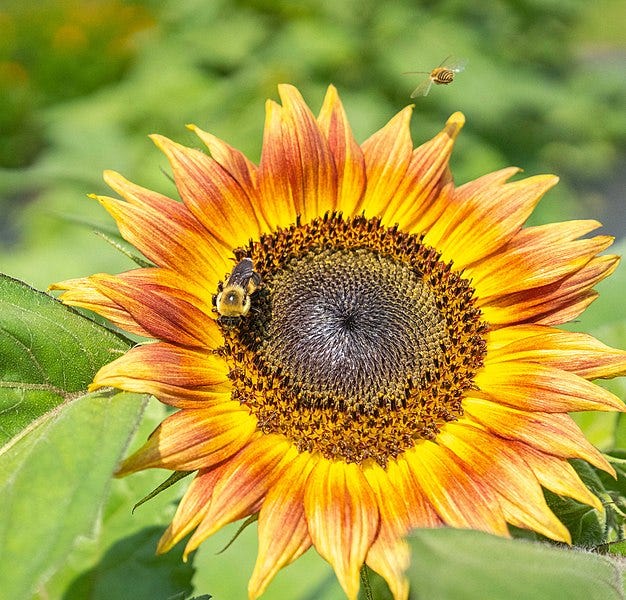
Regenerative agriculture incorporates a holistic, systems-based approach to farming that seeks to improve the quality, productivity, and biodiversity of the soil rather than, literally, treating it like dirt. The farm is seen as a complete ecosystem to be respected and worked with, rather than exploited through destructive tilling practices and pesticide spraying – the typical Big Ag methods. The regenerative technique of rotational grazing of livestock also plays an important part in the ecosystem of soil health. Animals nourish themselves on healthy grass and other plants, and the minerals they excrete strengthen and fertilize the soil.
Regenerative agriculture is a relatively recent term even though it involves traditional, and even ancient, farming practices. Around 2017, “sustainable” farming had become a buzzword in response to the large-scale American model that abuses the soil and produces food that is almost devoid of nutrients, as explained by rancher and Ranching Reboot podcast host Brian Alexander, in an interview with The Kennedy Beacon. Farmers from around the country banded together and, after much negotiation, agreed on six principles that constitute soil health, which is the basis of regenerative agriculture: (1) minimizing disturbance (no tilling); (2) prioritizing soil health (living roots); (3) integrating livestock; (4) increasing diversity; (5) covering the soil (naked soil is hot and dry; covered soil catches water better); and (6) knowing your context, as not all management techniques are appropriate in every setting.
Liz Haney and Russell Hedrick founded Soil Regen – a group that helps regenerative farmers find best practices, rather than letting big corporations “farm the farmers” by selling them chemicals and equipment they don’t need. Appearing on Alexander’s podcast, Haney defined regenerative agriculture as “trying to farm as best you can in nature’s image while in your context.” Hedrick elaborated by saying “regenerative agriculture is any practice that farmers can do to make the land better than how they found it.” These definitions are not prescriptive, but underline that there is no one-size-fits-all model of farming. Industrial agriculture does prescribe far-reaching, so-called best practices, but the reality is that every parcel of land is different and farmers know their plots better than anyone. Above all, the land must be respected, studied, and heard in order to function in the best way possible.
The regenerative approach would therefore involve revamping the industrial agriculture (Big Ag) system in the US, leading to food stability for future generations. Regenerative agriculture would also help return the soil to a state that facilitates its natural ability to capture carbon from the air as it benefits from living organisms, rather than being robbed of life.
The 2020 documentary film Kiss the Ground, featuring a longtime friend of Kennedy, Woody Harrelson, offers a compelling exploration of regenerative agriculture. The film shows how better practices can create a higher-quality food supply and a stronger topsoil layer that can absorb carbon, providing an effective and natural way to help resolve the issue of excess CO2 levels. These practices could also play a role in improving human health; a January 2022 study by David Montgomery and colleagues found that “regenerative soil-building farming practices can enhance the nutritional profile of conventionally grown plant and animal foods.”
When a healthier environment and a healthier population are taken together, it’s easy to see that regenerative agriculture provides a natural pathway to investing in a better American future, and can help solve many current societal health and economic problems, while creating robust safeguards against potential future health and environmental crises.
More Sustainable Profits for Farmers
Regenerative farmers are also discovering that healthier soil can lead to healthier profits. It is especially notable in face of the mantra “Get Big or Get Out,” which over the decades has led many farmers to believe, as small farm advocate Don Ashford observes, that they could not turn a profit unless they followed the Big Ag model. A 2018 study by the Ecdysis Foundation found that farmers who utilize regenerative agriculture methods tend to have higher profitability (nearly 80%) than farmers who use conventional practices.
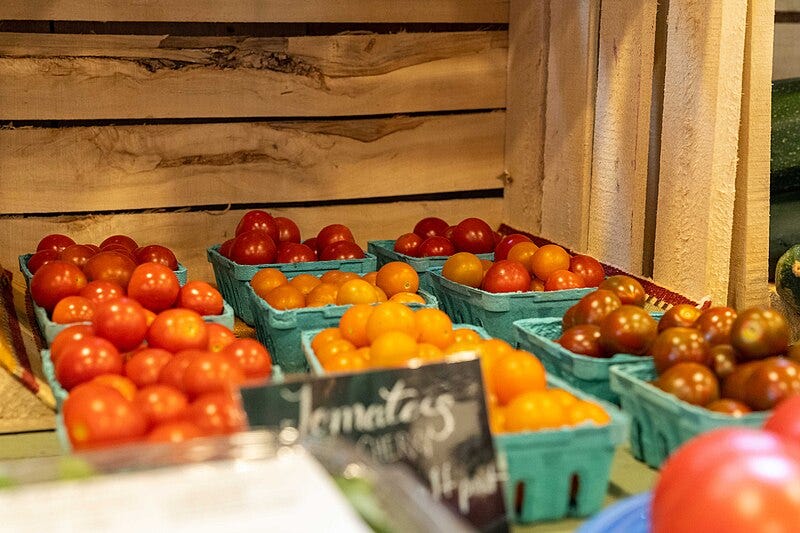
Will Harris, owner of the regenerative White Oak Pastures in Bluffton, Georgia, explained on Kennedy’s farming roundtable how another model is possible. Harris’s farm is the largest employer in Clay County, which is one of the poorest counties in the country, with a poverty rate of 26%, according to the World Population Review. Nevertheless, Harris pays all of his staff above minimum wage and provides health care benefits and a 401(k) plan, while his farm welcomes visitors and produces quality food that is available throughout the US. The success of his farm comes from utilizing regenerative agriculture practices that also enhance topsoil health.
In contrast, the environmentally abusive Big Ag monoculture farming methods will eventually exhaust the available topsoil. As the Natural Resources Defense Council reports, “Soil scientists believe that if current rates of soil degradation continue, all of the world’s topsoil could be gone within 60 years.” No more topsoil would render future farming, and therefore an American-grown food supply, potentially impossible, making local and healthy food inaccessible for future generations. This trend indicates that soil health may be a much more important problem to address than the amount of carbon being put into the atmosphere.
Health Problems Caused by Big Ag
The US government model prioritizes enormous, industrial monoculture crops and factory farm livestock. These methods focus on producing the most commodities possible – corn and soy for livestock feed, ethanol, high fructose corn syrup, and various starch additives for processed foods – at the lowest costs, thus increasing profits for Big Ag, but failing to provide quality food for the American people.
As previously discussed by Kennedy and investigated in depth by The Kennedy Beacon, the American population suffers from a growing epidemic of chronic disease and illness. Beth Mole in ArsTechnica reports that the US has the most expensive health care in the world with the worst health outcomes among its high-income peer countries. Evidently, what Americans are putting in their bodies directly impacts their physical health, and the current food system is simply not cutting it.
Big Ag relies enormously on the use of pesticides, which contaminate agricultural products (and the bodies of people consuming them), as well as the surrounding environment where these chemicals are sprayed. Moreover, farm animals and livestock are regularly dosed with antibiotics to mediate their pesticide-laden diet and unsanitary living conditions that often result in widespread disease and illness. In fact, 80% of antibiotics used in the US today are given to farm animals – which, a study by Michael J. Martin and colleagues warns, could become a serious threat to human health as well. This problem is so rampant that antibiotic-resistant bacteria have spread to human populations, as explained by the CDC.
Conclusion
In part 2 of this series, I’ll critique how Big Ag and Big Government are addressing the problem of carbon emissions, compared to the regenerative method. Industrial agriculture is also one of the world’s largest sources of air pollution, according to a study by Susanne Bauer and colleagues. In addition, widespread use of pesticides, as well as exhausting the land through tilling, also causes environmental damage through chemical runoff into watersheds and improper use of existing water resources.
In part 3, I interview Brian Alexander, a rancher in Kansas who is using cows to sequester carbon the natural way.
Will Harris, Liz Haney, Russell Hedrick, and Brian Alexander are just a few examples of farmers/ranchers finding better models, but the country’s food systems will need a major revamp to make regenerative agriculture more widespread. It is therefore extremely important to the health of the entire country that Robert F. Kennedy Jr. recognizes the importance of this issue and wants to consult with farmers, rather than just industry executives, to improve food systems. You are what you eat, and Americans need better than what they’re being fed.
Nikos Biggs-Chiropolos studied government at Georgetown University and interned for several Democratic elected officials and their campaigns, and other affiliated groups. He then earned a master’s degree in urban studies in France, where extremely strict COVID-19 lockdowns led to his political reawakening and inspired him to try to help fix the broken two-party system.
-

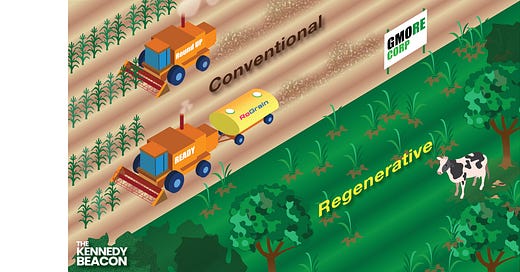


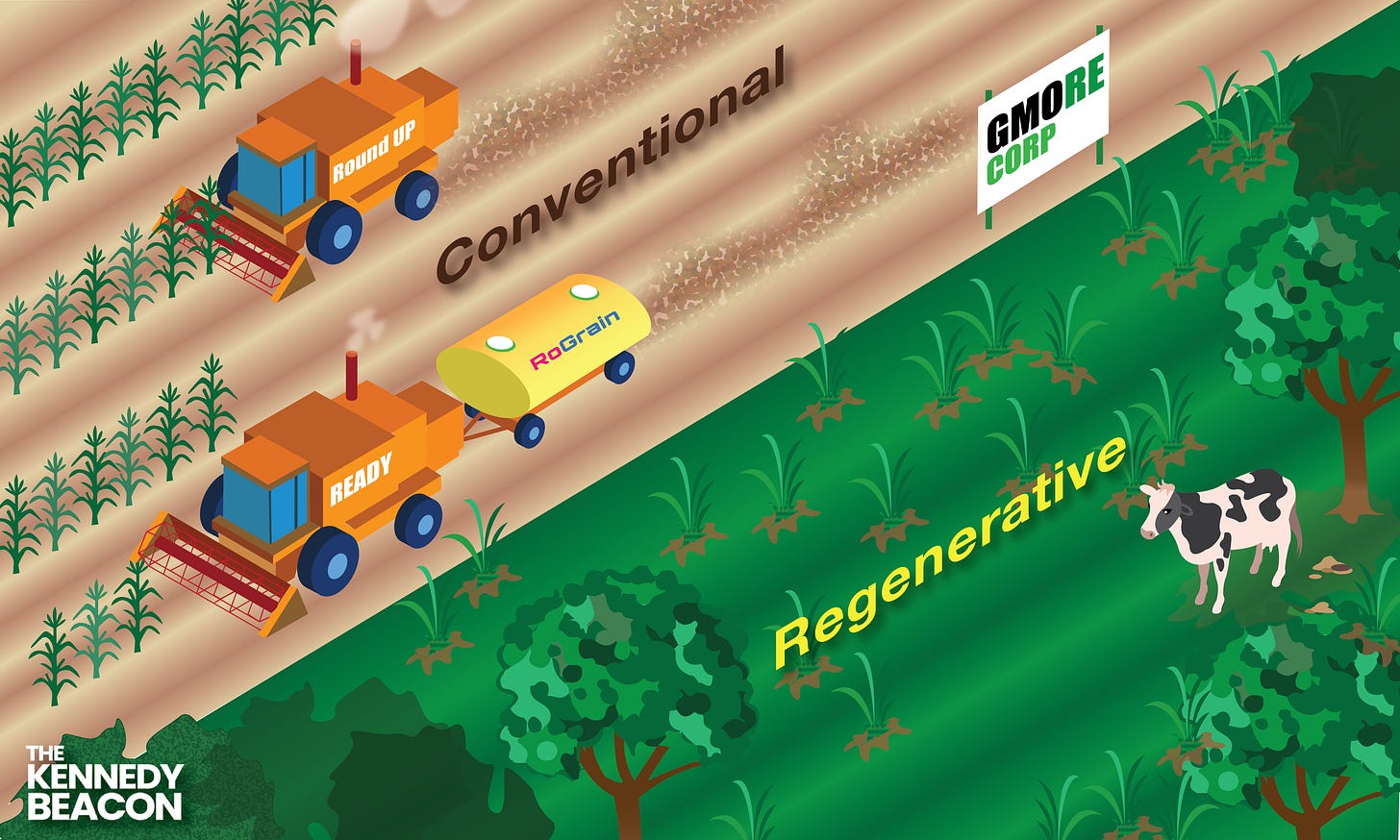
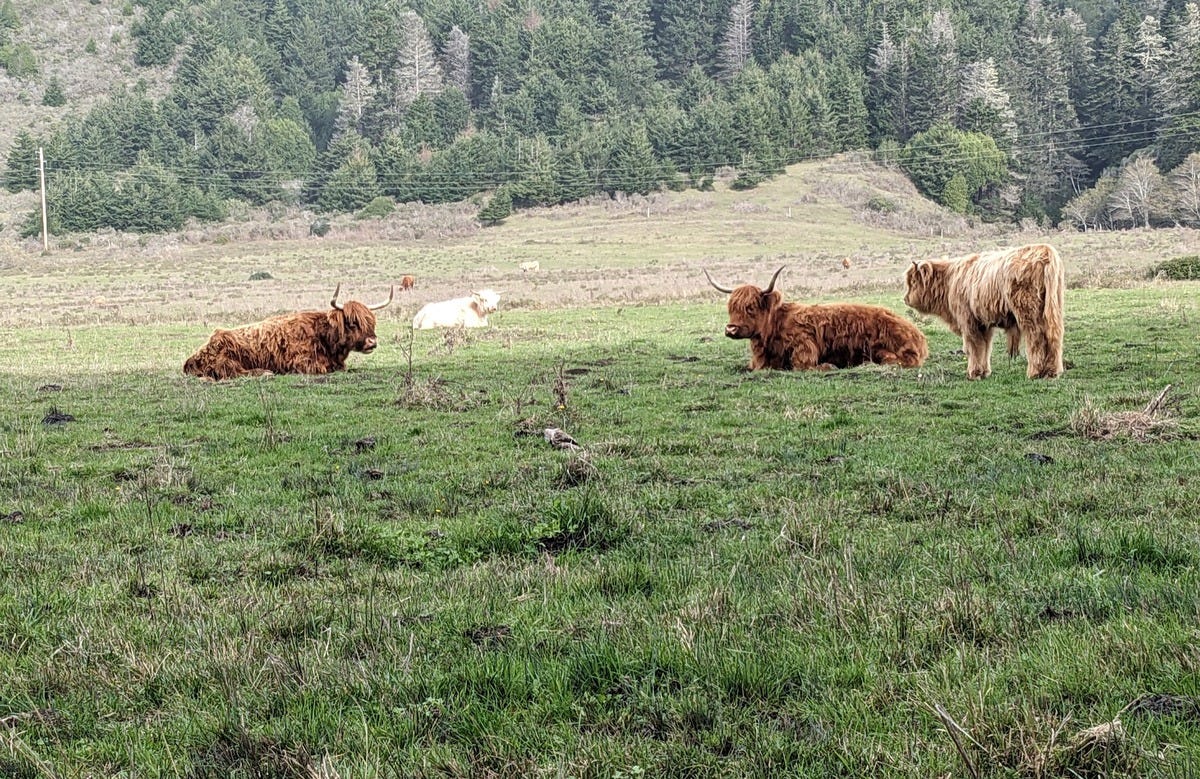
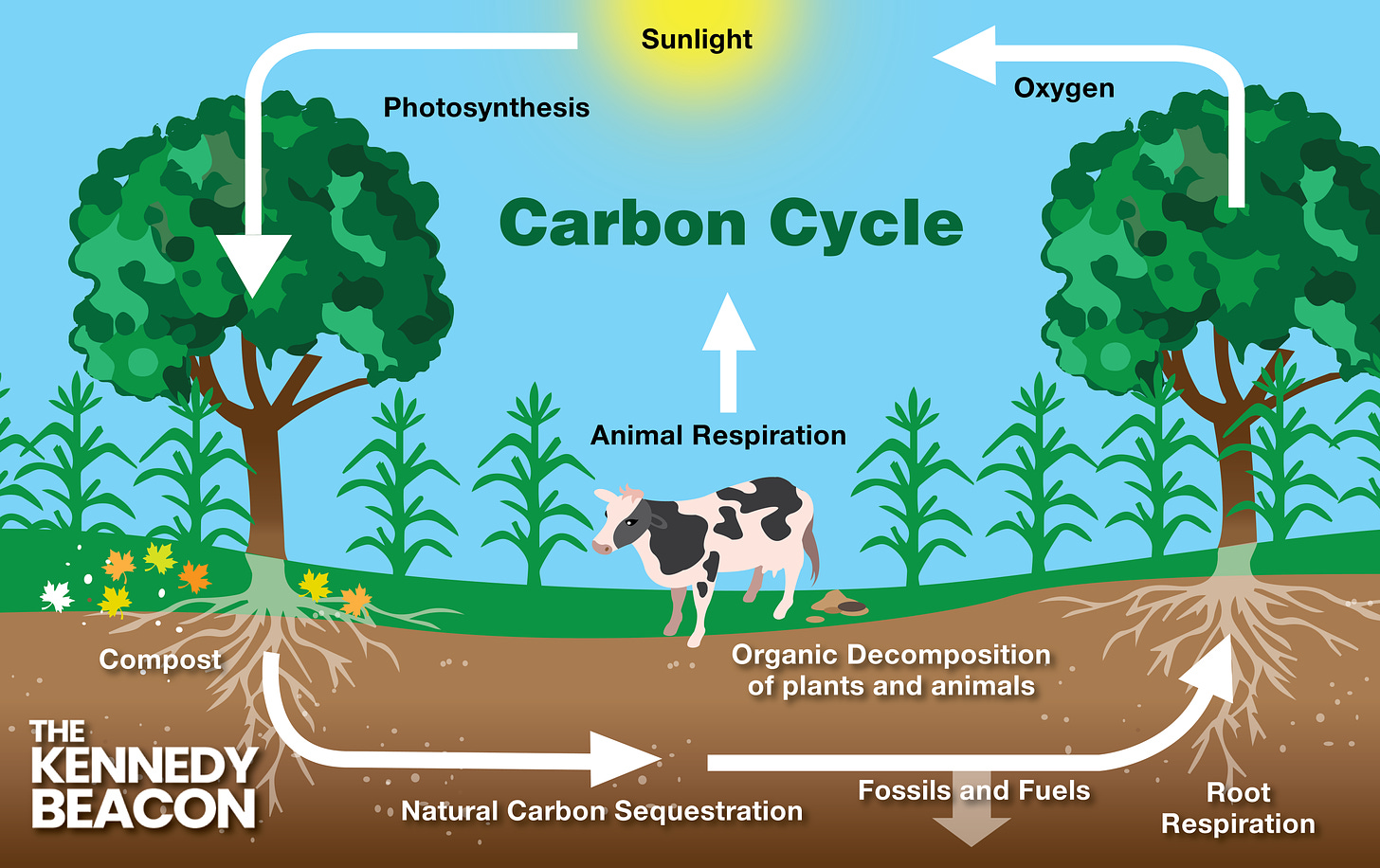

I'm all in on this one. Have done organic farming. Healthy soil is key!! So is real sustainable family farming. We had two acres. Never ate so well! Of course I had a day job. But the whole family worked the gardens and tended the chickens and turkeys.
https://www.claritypress.com/product/our-country-then-and-now/
It can start with the rejection of processed foods. Buy healthy meat and eggs from local farms. If is is in a box and says "Natural" it isn't. If it says "Plant Based" and the ingredient list reads like a toxic waste dump DO NOT BUY IT.